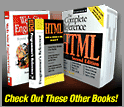
















|
 |

The actual syntax of HTML is very well defined by a document type definition (DTD). In fact, all files should begin with a <!DOCTYPE> declaration, which is used to indicate the particular version of HTML being employed in a page. You might recall noticing them at the top of the source of many Web pages. This page lists the most common HTML DTD indicators.
HTML 2.0
<!DOCTYPE HTML PUBLIC "-//IETF//DTD HTML//EN">
This version of HTML is equivalent to what is supported by early versions of Netscape and mostly many presentation features of HTML that developers rely on. Few sites use strictly HTML 2.0 given its limited capabilities.
HTML 3.2
<!DOCTYPE HTML PUBLIC "-//W3C//DTD HTML 3.2 Final//EN">
This version of HTML is similar to what is supported by 3.x x-generation browsers. Many of the acceptable browser- introduced proprietary tags were adopted for this version of HTML.
HTML 4.0 - Transitional
<!DOCTYPE HTML PUBLIC "-//W3C//DTD HTML 4.0 Transitional//EN" "http://www.w3.org/TR/REC-html40/loose.dtd">
The transitional version of HTML 4.0 is roughly equivalent to what 4.x x-generation browsers support. However, no single browser at the time of this book's writing is fully HTML 4.0 compliant despite the specification having been out for approaching three years. The transitional form of HTML 4 preserves most of the presentational markup aspects commonly employed by Web designers.
HTML 4.0 - Frameset
<!DOCTYPE HTML PUBLIC "-//W3C//DTD HTML 4.0 Frameset//EN">
The frameset DTD is an auxiliary definition to deal with the use of frames in a document. It only defines the frame syntax and otherwise relies on the transitional DTD.
HTML 4.0 - Strict
<!DOCTYPE HTML PUBLIC "-//W3C//DTD HTML 4.0//EN">
The strict version of HTML 4 removes nearly all the presentation presentation-oriented markup elements in favor of using CSS for page formatting. This greatly simplifies the language, but it forces the developer to rely on CSS that is not properly supported in 4.x- and even 5.x x-generation browsers.
HTML 4.01 - Transitional
<!DOCTYPE HTML PUBLIC "-//W3C//DTD HTML 4.01 Transitional//EN">
A minor update release of the 4.0 specification that addresses errors and oversights in the original release.
HTML 4.01 - Frameset
<!DOCTYPE HTML PUBLIC "-//W3C//DTD HTML 4.01 Frameset//EN">
The update release of the frameset auxiliary DTD.
HTML 4.01 - Strict
<!DOCTYPE HTML PUBLIC "-//W3C//DTD HTML 4.01//EN">
A minor update release of the 4.0 strict specification that addresses errors and oversights in the original 4.0 specification.
XHTML 1.0 - Transitional
<!DOCTYPE html PUBLIC "-//W3C//DTD XHTML 1.0 Transitional//EN" "DTD/xhtml1-transitional.dtd">
The XHTML 1.0 version of the HTML 4 transitional specification.
XHTML 1.0 - Strict
<!DOCTYPE html PUBLIC "-//W3C//DTD XHTML 1.0 Strict//EN" "DTD/xhtml1-strict.dtd">
The XHTML 1.0 version of the HTML 4 strict specification.
XHTML 1.0 - Frameset
<!DOCTYPE html PUBLIC "-//W3C//DTD XHTML 1.0 Frameset//EN" "DTD/xhtml1-frameset.dtd">
The XHTML 1.0 version of the HTML 4 frameset specification.
|



